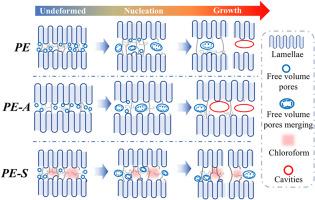The initiation and growth mechanism of cavitation effect during stretching of high-density polyethylene
IF 4.5
2区 化学
Q2 POLYMER SCIENCE
引用次数: 0
Abstract
Cavitation is a critical phenomenon to determine the mechanical performance and failure behavior of semicrystalline polymers. However, the initiation and growth mechanism of cavitation is still under debate. In this work, the cavitation behavior of high-density polyethylene (HDPE) was investigated systematically from the perspectives of crystal thickness and free-volume pores in amorphous phase, employing the in situ wide-angle X-ray diffraction (WAXD), small-angle X-ray scattering (SAXS), and minute-scale positron annihilation lifetime spectroscopy (PALS) analysis. It is found that cavities are originated from the coalescence of pre-existing free-volume pores, not by the expansion of individual free-volume pore. For the chloroform modified sample, solvent fills the amorphous phase and reduces the fraction of free volume by 47.2%, which prevents the coalescence of free-volume pores and thus the initiation of cavitation is suppressed completely. On the other hand, annealing improves the lamellae thickness of PE and can undergo higher negative pressure generated by the surface tension of growing cavities, resulting in the most pronounced cavitation effect. These findings provide new insights into the cavitation mechanism of semicrystalline polymers.

高密度聚乙烯拉伸过程中空化效应的产生与成长机理
空化现象是决定半晶聚合物力学性能和破坏行为的关键现象。然而,空化的产生和生长机制仍存在争议。本文采用原位广角x射线衍射(WAXD)、小角x射线散射(SAXS)和分尺度正电子湮灭寿命谱(PALS)分析,从晶体厚度和非晶相自由体积孔的角度系统地研究了高密度聚乙烯(HDPE)的空化行为。研究发现,空腔是由已有的自由体积孔隙合并而成,而不是由单个自由体积孔隙扩张而成。对于氯仿改性样品,溶剂填充了非晶相,使自由体积分数降低了47.2%,从而阻止了自由体积孔隙的聚并,从而完全抑制了空化的发生。另一方面,退火提高了PE的片层厚度,可以承受由生长空腔表面张力产生的较高负压,导致空化效应最为明显。这些发现为研究半结晶聚合物的空化机理提供了新的思路。
本文章由计算机程序翻译,如有差异,请以英文原文为准。
求助全文
约1分钟内获得全文
求助全文
来源期刊

Polymer
化学-高分子科学
CiteScore
7.90
自引率
8.70%
发文量
959
审稿时长
32 days
期刊介绍:
Polymer is an interdisciplinary journal dedicated to publishing innovative and significant advances in Polymer Physics, Chemistry and Technology. We welcome submissions on polymer hybrids, nanocomposites, characterisation and self-assembly. Polymer also publishes work on the technological application of polymers in energy and optoelectronics.
The main scope is covered but not limited to the following core areas:
Polymer Materials
Nanocomposites and hybrid nanomaterials
Polymer blends, films, fibres, networks and porous materials
Physical Characterization
Characterisation, modelling and simulation* of molecular and materials properties in bulk, solution, and thin films
Polymer Engineering
Advanced multiscale processing methods
Polymer Synthesis, Modification and Self-assembly
Including designer polymer architectures, mechanisms and kinetics, and supramolecular polymerization
Technological Applications
Polymers for energy generation and storage
Polymer membranes for separation technology
Polymers for opto- and microelectronics.
 求助内容:
求助内容: 应助结果提醒方式:
应助结果提醒方式:


